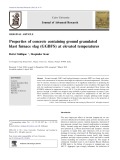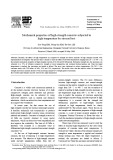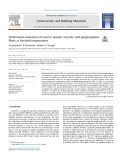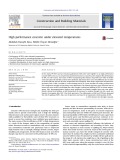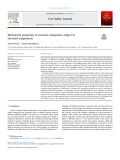
Concrete subjected to temperatures
-
In the past decade, calcium aluminate cement is widely used to manufacture refractory concrete for infrastructure works which frequently were subjected to elevated temperature thanks to the thermal stability by the high content of aluminum. This paper presents experimental results of the physical, thermal, and mechanical properties of calcium aluminate cement-based refractory concrete specimens.
 15p
15p  viargus
viargus
 20-02-2023
20-02-2023
 9
9
 2
2
 Download
Download
-
This paper proves that, given a Load-Induced Thermal Strain (LITS) curve able to accurately describe the uniaxial LITS development for a specific type of concrete and temperatures up to 500 °C, a more accurate prediction of the 3D LITS state is obtained through a confinement-dependent 3D implementation than through the classic confinement-independent approach.
 10p
10p  guernsey
guernsey
 28-12-2021
28-12-2021
 11
11
 0
0
 Download
Download
-
This study presents an investigation on the design of long reinforced concrete (RC) structures subjected to uniform temperature load by considering three RC frame building models with different lengths of 45 m, 135 m, and 270 m using Etabs. The uniform temperature load is considered being the change from the annual average highest to lowest air temperature at the construction site in the case of unavailable temperature data of concrete.
 13p
13p  inception36
inception36
 30-11-2021
30-11-2021
 6
6
 2
2
 Download
Download
-
Normal strength (NSC) and high-performance concretes (HPC) are being used extensively in the construction of structures that might be subjected to elevated temperatures. The behaviour of concrete structures at elevated temperatures is of significant importance in predicting the safety of structures in response to certain accidents or particular service conditions. This paper deals with the mechanical properties of concrete made with ground granulated blast furnace slag (GGBFS) subjected to temperatures up to 350 C.
 7p
7p  kethamoi1
kethamoi1
 17-11-2019
17-11-2019
 11
11
 2
2
 Download
Download
-
Recently, the effects of high temperature on compressive strength and elastic modulus of high strength concrete were experimentally investigated. The present study is aimed to study the effect of elevated temperatures ranging from 20 ℃ to 700 ℃ on the material mechanical properties of high-strength concrete of 40, 60 and 80 MPa grade. During the strength test, the specimens are subjected to a 25% of ultimate compressive strength at room temperature and sustained during heating, and when the target temperature is reached, the specimens are loaded to failure.
 6p
6p  christian2605
christian2605
 10-10-2019
10-10-2019
 15
15
 0
0
 Download
Download
-
Reactive Powder Concrete (RPC) is a type of ultra-high strength concrete. Due to its dense microstructure, is vulnerable to explosive spalling at elevated temperatures. Remarkable application of RPC in special structures throughout the world has drawn the attention to understand the performance of RPC at elevated temperatures, which has not been investigated extensively yet. The main objective of this work was to evaluate the performance of RPC at elevated temperatures from 200 C to 800 C, by obtaining residual mechanical properties after exposure.
 14p
14p  christian2605
christian2605
 10-10-2019
10-10-2019
 17
17
 0
0
 Download
Download
-
In this study, PP fibers and air entraining admixture (AEA) were used together in an high performance concrete (HPC) mix so as to create interconnected reservoirs in concrete and to improve fire performance of HPC. For this reason, nine mixes of HPC incorporating blast furnace slag with 0.24 water-to-binder ratio and various PP and AEA contents were produced. Specimens were cast in two different sizes in order to see the effect of size and 18 series of specimens were obtained.
 12p
12p  christian2605
christian2605
 10-10-2019
10-10-2019
 20
20
 1
1
 Download
Download
-
Concrete is an inherently brittle material with a relatively low tensile strength compared to compressive strength. Reinforcement with randomly distributed short fibres presents an effective approach to the stabilization of the crack and improving the ductility and tensile strength of concrete. A variety of fibre types, including steel, synthetics, and natural fibres, have been applied to concrete. Polypropylene (PP) fibre reinforcement is considered to be an effective method for improving the shrinkage cracking characteristics, toughness, and impact resistance of concrete materials.
 20p
20p  christian2605
christian2605
 10-10-2019
10-10-2019
 14
14
 1
1
 Download
Download
-
The paper deals with observing the behaviour of concrete composites with addition of fibres under ambient and elevated temperature with the aim to determine the mechanical properties of materials. The experimental tests were conducted on three selected concrete composites which differ in a type and content of fibrous reinforcement used. The experimental work carried out was divided into several phases. First of all it was necessary to leave the produced specimens aging and drying in order to minimize the risk of unexpected damage caused by concrete spalling during heating.
 11p
11p  christian2605
christian2605
 10-10-2019
10-10-2019
 33
33
 0
0
 Download
Download










